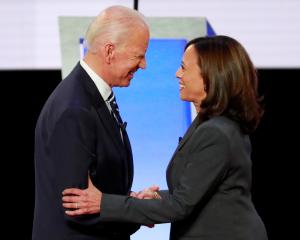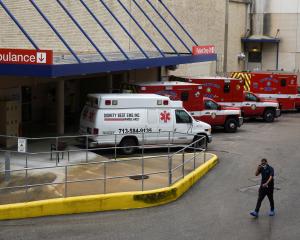
North Korea fired a missile on Friday (local time) that experts said was capable of hitting Los Angeles and other US cities and the United States and South Korea responded by staging a joint missile exercise.
North Korea confirmed the launch on Saturday, with its official news agency saying it was a "stern warning" for the United States. President Kim Jong Un said the missile showed that all of the United States was within striking distance but US authorities characterised that as an exaggeration.
The administration of US President Donald Trump, which has branded North Korea the "most urgent and dangerous threat to peace," condemned the launch as reckless.
"By threatening the world, these weapons and tests further isolate North Korea, weaken its economy, and deprive its people," President Donald Trump said in a statement. "The United States will take all necessary steps to ensure the security of the American homeland and protect our allies in the region."
South Korean Defence Minister Song Young-moo said at a news conference on Saturday Seoul would prepare independent measures to curb the nuclear threat from the North.
"This ballistic missile launch by North Korea is a serious provocation that not only clearly violates the UN Security Council’s numerous resolutions but also threatens the safety of the Korean peninsula and world peace," Song said. "The joint governments of South Korea and the United States will firmly punish North Korea for its missile provocation."

He said steps would be taken to hasten the temporary deployment of THAAD anti-missile units from the United States.
The unusual late-night launch added to exasperation in Washington, Seoul and Tokyo over Pyongyang's continuing development of nuclear weapons and intercontinental ballistic missiles (ICBMs). Friday's test prompted US and South Korean military officials to discuss military response options.
The North Korean military had already raised alarms early this month with its first ICBM launch.
The top US military official, Joint Chiefs of Staff Chairman Joseph Dunford, and Admiral Harry Harris, commander of US Pacific Command, spoke by phone with the top South Korean military official, General Lee Sun-jin, to discuss military response options to the launch.
The Trump administration has said that all options are on the table, including military ones, however it has also made clear that diplomacy and sanctions are its preferred course.

Following a meeting of South Korea's National Security Council, South Korean President Moon Jae-in said he wanted the UN Security Council to discuss new and stronger sanctions against the North, the presidential Blue House said.
Later the United States and South Korea conducted a live-fire ballistic missile exercise in a display of firepower in response to the missile launch, the US military said.
The two allies had staged a similar exercise after the North Korean test earlier in the month.
Japanese Chief Cabinet Secretary Yoshihide Suga said the missile flew for about 45 minutes before apparently landing in the waters of Japan's exclusive economic zone. Japanese broadcaster NHK, citing a military official, said the missile reached an altitude of more than 3000km.
US CITIES IN RANGE

The South Korean military said the missile was believed to be an ICBM-class, flying more than 1000km and reaching an altitude of 3700km. In Washington, the Pentagon also said it had assessed that the missile was an ICBM.
US officials said the Defense Intelligence Agency (DIA), the Pentagon spy agency, has determined that North Korea will be able to field a reliable nuclear-capable ICBM by next year, earlier than previously thought.
Jeffrey Lewis of the California-based Middlebury Institute of International Studies said the launch showed Los Angeles was within range of a North Korean missile, with Chicago, New York and Washington, just out of reach.
"They may not have demonstrated the full range. The computer models suggest it can hit all of those targets," he said.
The US-based Union of Concerned Scientists said its calculations showed the missile could have been capable of going as far into the United States as Denver and Chicago.
Michael Elleman of the International Institute for Strategic Studies said the window for a diplomatic solution with North Korea "is closing rapidly."

"The key here is that North Korea has a second successful test in less than one month," he said. "If this trend holds, they could establish an acceptably reliable ICBM before year's end."
John Schilling, an aerospace expert and a contributor to 38 North, a Washington-based North Korea monitoring website, said the improved performance over the previous test could have been the result of a lighter payload as part of an effort to demonstrate that the missile could hit the US capital.
Los Angeles would be protected by the US missile defence network, which includes four ground-based interceptors at Vandenberg Air Force base, 150 miles north of the city, and a second battery of 32 missiles in Alaska.
During a test on May 31 the missile defence system shot down an incoming ICBM missile aimed at the US mainland and a Pentagon spokesman said the military had "confidence in our ability to defend against the limited threat."
Other authorities say the United States may not be able to seal itself off entirely from a North Korean ICBM attack.












